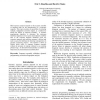Free Online Productivity Tools
i2Speak
i2Symbol
i2OCR
iTex2Img
iWeb2Print
iWeb2Shot
i2Type
iPdf2Split
iPdf2Merge
i2Bopomofo
i2Arabic
i2Style
i2Image
i2PDF
iLatex2Rtf
Sci2ools
106
click to vote
ISMB
1998
1998
Sequence Assembly Validation by Multiple Restriction Digest Fragment Coverage Analysis
DNA sequence analysis depends on the accurate assembly of fragment reads for the determination of a consensus sequence. This report examines the possibility of analyzing multiple, independent restriction digests as a method for testing the fidelity of sequence assembly. A dynamic programming algorithm to determine the maximum likelihood alignment of error prone electrophoretic mobility data to the expected fragment mobilities given the consensus sequence and restriction enzymes is derived and used to assess the likelihood of detecting rearrangements in genomic sequencing projects. The method is shown to reliably detect errors in sequence fragment assembly without the necessity of making reference to an overlying physical map. An html form-based interface is available at http://www.ibc.wustl.edu/services/validate.html
Computational Biology | Consensus Sequence | DNA Sequence Analysis | ISMB 1998 | Sequence Fragment Assembly |
| Added | 01 Nov 2010 |
| Updated | 01 Nov 2010 |
| Type | Conference |
| Year | 1998 |
| Where | ISMB |
| Authors | Eric C. Rouchka, David J. States |
Comments (0)

